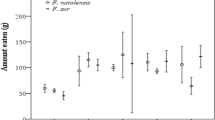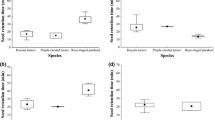Abstract
McKey's (1975) hypothesis that avian dispersers with a specialized gut provide higher quality seed dispersal than unspecialized frugivores was tested using grey mistletoe (Amyema quandang) fruits, and captive mistletoebirds (Dicaeum hirundinaceum) and spinycheeked honeyeaters (Acanthagenys refogularis) in arid South Australia. Mistletoebirds have a specialized gut, unlike spiny-cheeked honeyeaters. The gut passage time of A. quandang fruits through mistletoebirds was 820±29 s (mean±SE, n=188), compared to 2434±36 s (n=436) for honeyeaters. The seeds defecated by both bird species were deployed on twigs of host trees. Despite the longer retention time of fruit in the gut of honeyeaters, the germination percentage of seeds defecated by mistletoebirds (85% of 485 seeds) and honeyeaters (81% of 485 seeds) did not differ significantly 1 week after deployment. However, after 5 months, a significantly greater proportion of seedlings had established from seeds passed by mistletoebirds (42.7%) than from seeds defecated by honeyeaters (31.1%). The data support the notion that the more gentle treatment of seeds in the gut of specialized dispersers translates into higher seedling establishment.
Similar content being viewed by others
References
Ali SA (1931) The role of the sunbirds and the flowerpeckers in the propagation and distribution of the tree parasite, Loranthus longiflorus Dest., in the Konkan (W. India). J Bomb Nat Hist Soc 35: 144–149
Becker RA, Chambers JM, Wilks AR (1988) The new S language: a programming environment for data analysis and graphics. Wadsworth and Brooks/Cole, New York, 702 p
Docters van Leeuwen WM (1954) On the biology of some Javanese Loranthaceae and the role birds play in their life history. Beaufortia 4: 105–207
Herrera CM (1985) Determinants of plant-animal coevolution: the case of mutualistic dispersal of seeds by vertebrates. Oikos 44: 132–141
Howe HF, Primack RB (1975) Differential seed dispersal by birds of the tree Caesaria nitida (Flacourtiaceae). Biotropica 7: 278–283
Keast A (1958) The influence of ecology on variation in the mistletoebird, (Dicaeum hirundinaceum). Emu 58: 195–206
Levey DJ (1991) Digestive processing of fruits and its consequences for fruit-frugivore coevolution. Acta XX Congr Int Ornithol, New Zealand Ornithol Congress Trust Board, Wellington pp 1624–1629
McKey D (1975) The ecology of coevolved seed dispersal systems. In: Gilbert LE, Raven PH (eds) Coevolution of animals and plants. University of Texas Press, Austin, pp 159–191
Moermond TC, Denslow JS (1985) Neotropical avian frugivores: patterns of behavior, morphology, and nutrition, with consequences for fruit selection. In: Buckley PA, Foster MS, Morton ES, Ridgeley RS, Buckley FG (eds) Neotropical ornithology. Ornith Monogr No 36. Am Ornith Union, Washington DC, pp 865–897
Reid N (1989) Dispersal of mistletoes by honeyeaters and flowerpeckers: components of seed dispersal quality. Ecology 70: 137–145
Reid N (1990) Mutualistic interdependence between mistletoes (Amyema quandang) and spiny-cheeked honeyeaters and mistletoebirds in an arid woodland. Aust J Ecol 15: 175–190
Reid N (1991) Coevolution of mistletoe and frugivorous birds? Aust J Ecol 16: 457–469
Richardson KC, Wooller RD (1986) The structures of the gastrointestinal tracts of honeyeaters and other small birds in relation to their diets. Aust J Zool 34: 119–124
Richardson KC, Wooller RD (1988) The alimentary tract of a specialist frugivore, the mistletoebird, Dicaeum hirundinaceum, in relation to its diet. Aust J Zool 36: 373–382
Rick CM, Bowman RI (1961) Galapagos tomatoes and tortoises. Evolution 15: 407–417
Ryan GM (1899) The spread of Loranthus in the South Thana Division, Konkan. Indian For 25: 472–476
Snow DW (1971) Evolutionary aspects of fruit-eating by birds. Ibis 113: 194–202
Wooller RD, Richardson KC (1988) Morphological relationships of passerine birds from Australia and New Guinea in relation to their diets. Zool J Linn Soc 94: 193–201
Author information
Authors and Affiliations
Rights and permissions
About this article
Cite this article
Murphy, S.R., Reid, N., Yan, Z. et al. Differential passage time of mistletoe fruits through the gut of honeyeaters and flowerpeckers: effects on seedling establishment. Oecologia 93, 171–176 (1993). https://doi.org/10.1007/BF00317667
Received:
Accepted:
Issue Date:
DOI: https://doi.org/10.1007/BF00317667




